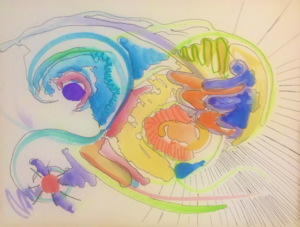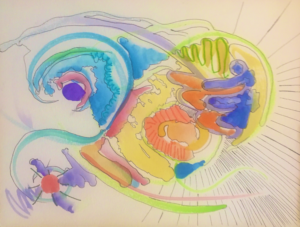“Relax. Nothing is under control.” ~Adi DA
I recently (re)discovered the book Full Catastrophe Living by Jon Kabat-Zinn, an updated edition of the classic book in the field of mindfulness. I came across the book in Powells ‘City of Books’ in Portland Oregon, which basically represents my own personal heaven. I promised myself that I wouldn’t buy any books, and then I bought three. (But I was mindful about it!)
I am in Portland this week, having assisted with an amazing seminar with Wings Seminars as part of my internship with them this year, and the above quote was one of the ones that stuck with me from the weekend. I am very aware that part of my habitual patterns under stress is to think I need to control myself and my process, that if I am careful enough, that I can somehow keep myself safe by just Making. Sure. That. Everything. Is. Right. And. Good. And Perfect. Now no one move or breathe!
 In Full Catastrophe Living, Jon Kabat-Zinn explores how mindfulness can assist us in alleviating our suffering and others’ suffering by simply bringing more awareness and compassion to our habitual patterns. I love the book’s title, and how he invites his readers to embrace mindfulness while not soft-pedaling any of the hard things in life: how the world is not always a safe place; how others let us down, and we let others down; how our hearts get broken open; how we get disappointed and disillusioned. All of this is true. And if all of this is true, then how can we be with ourselves and with others in the midst of all of this in a way that is both compassionate and real? Are we courageous enough to love and embrace life, even in the midst of catastrophe?
In Full Catastrophe Living, Jon Kabat-Zinn explores how mindfulness can assist us in alleviating our suffering and others’ suffering by simply bringing more awareness and compassion to our habitual patterns. I love the book’s title, and how he invites his readers to embrace mindfulness while not soft-pedaling any of the hard things in life: how the world is not always a safe place; how others let us down, and we let others down; how our hearts get broken open; how we get disappointed and disillusioned. All of this is true. And if all of this is true, then how can we be with ourselves and with others in the midst of all of this in a way that is both compassionate and real? Are we courageous enough to love and embrace life, even in the midst of catastrophe?
This has been an ongoing process and practice for me, and is central to the work I do with clients.
- Can I admit that I am afraid, and still do what must be done?
- Can I acknowledge and own that my heart is broken, and speak the truth, even when I don’t know what the outcome will be?
- Can I open up my hands and drop the old patterns I developed early in my life in order to feel safe, even though I truly don’t know what might happen?
- Am I willing to risk not knowing?
- Am I willing to accept that I am not in control?
Over the past several years, I have challenged myself to find the right balance between challenge and support, seeking learning environments that felt safe enough for me to begin to untangle my habitual patterns and receive feedback on ways that I am holding myself back. The biggest thing that I have learned is that telling myself the truth is foundational. If I or others around me try to pull punches and tell me that “everything is okay”, part of me calls B.S, and I’m less willing to risk because I feel lied to. I know that not everything is “okay.” And paradoxically, it is when I fully embrace the terror and risk of living in integrity with myself in a chaotic world that I am suddenly wholeheartedly onboard with leaning into my life, heart wide open.
Hiding in a numbed-out bubble or following the rules to try to feel safe and in control is also a risk. That’s the thing: the risk is present regardless of whether I act courageously in line with my values or I don’t.
I repeat: the risks in life are always present. Life is risky. We are all terminal cases.
So the framework becomes:
“Yes, the world is both beautiful and terrible, both full of comforting and supportive spaces and also deeply unsafe places and people. I will not live forever. The world is both and all. No, you are not safe. No, there is no formula you can follow to change this.
So what am I going to do about it?”
At some point in college, I remember realizing that world hunger and poverty would probably still exist after I was dead, and I remember that it hit me quite hard. On some level, some younger part of my brain had unconsciously held out a hope that my generation would be the one to fix the world’s problems ‘once and for all.’
What if we won’t? What if it’s too late? What if the planet is dying? What if suffering will continue long after we’re gone?
What then?
Food for Thought:
Catch yourself in the act of making decisions or taking action from a place of fear. Next, see if you can reframe your thinking so that you are envisioning and moving towards an outcome that you really yearn for.
For me, the fear-based thinking looks like “I’m going to do ‘x’ so that ‘y’ doesn’t happen.” Here are some examples:
- “I’m going to call this friend so that she doesn’t feel ignored and/or get mad at me.”
This could be reframed as:
“It is important to me to build and maintain deep friendships, so I am going to make time to call my friend this week to connect with her because I love her.”
- “I’m going to send this email today so that so-and-so doesn’t think I’m being lazy and dropping the ball.”
This could be reframed as:
“I am on board with our shared project and vision, and I value clear communication. I am going to make time this week to take the next steps that I have committed to and to communicate about my progress.”
- “I’m going to go to the gym so that I don’t feel bad about myself later.”
This could be reframed as:
“I want to feel strong and healthy in my body, so I am keeping my promise to myself to go to the gym.”
- “I’m going to use less plastic so that the situation on the planet doesn’t get worse quite as quickly, but I still feel guilty all the time and I feel afraid that it’s not enough.”
This could be reframed as:
“I want to live on a planet where my individual decisions have a neutral or positive impact on the planet, and where the full life-cycle of products is taken into account in design, manufacturing, and transportation. I acknowledge that the situation on the planet is serious, and I am committing to taking steps on a regular basis to shift my individual patterns of consumption and also doing my part to shift our systems and incentive structures in the world I live in. I am willing to see the stakes clearly, and I am doing what I can to contribute to the world I want to live in.”
Fear-based thinking is prevalent in our world, (where I identify a problem that must be fixed). This is a way of trying to impose control on a world that can feel chaotic and scary. Yes, the world can be chaotic and scary. If you can accept the full catastrophe of living, and then still courageously name and move towards what you want, you can create astounding results.
Good luck, my friends!

No responses yet